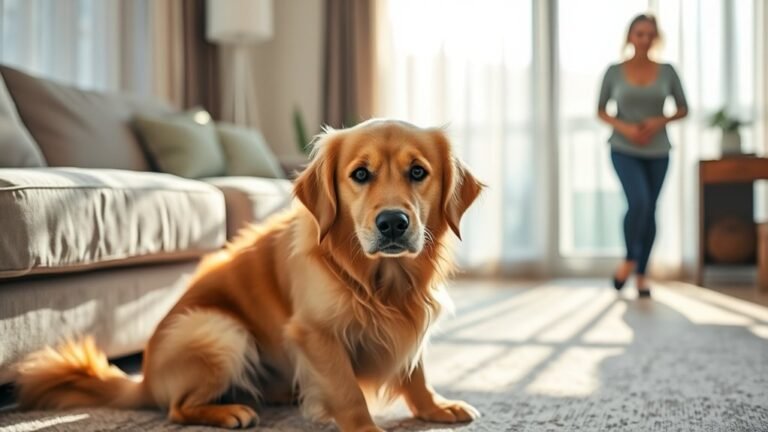Foods That Cause Stomach Aches in Dogs
Dogs can't eat all human foods. Some common foods can make them sick. Dairy products can upset their stomach, especially if they can't digest lactose. Rich or fatty foods can cause serious issues like pancreatitis. Knowing which foods to avoid can help keep your dog happy and healthy.
What other foods should you watch out for? Here are a few more common items to be careful about:
- Chocolate: This is very dangerous for dogs. It can cause serious health problems.
- Grapes and raisins: These can lead to kidney failure in some dogs.
- Onions and garlic: These can harm a dog's red blood cells and lead to anemia.
- Avocado: This contains a toxin that can be harmful to dogs.
- Macadamia nuts: Even small amounts can make dogs sick.
If you're not sure whether a food is safe for your dog, it's best to ask your veterinarian. Keeping an eye on what your dog eats will help them stay healthy and feel good!
Key Takeaways
Some foods can upset your dog's stomach. Here are a few to watch out for:
- Greasy or fatty foods: These can make your dog feel sick and can even cause serious problems like pancreatitis.
- Dairy products: Many dogs can't handle dairy well because of lactose intolerance. This can lead to gas and diarrhea.
- Certain grains: Grains like wheat and corn might cause bloating and gas, making your dog uncomfortable.
- Toxic foods: Some foods are dangerous for dogs, like chocolate, grapes, and onions. These can cause serious health issues, including stomach aches.
Always talk to your vet before giving your dog new foods. This can help you avoid any tummy troubles! Remember, keeping your dog's diet safe and healthy is important for their well-being.
Common Human Foods That Upset Dog Stomachs
Sharing food with your dog can be fun, but it's important to know that not all human foods are safe for them. Some treats and snacks that people love can upset your dog's stomach.
For example, chocolate, grapes, and onions are bad for dogs. They've harmful substances that can make your pet very sick.
Also, giving your dog table scraps that are greasy or spicy can lead to tummy troubles. Even things that seem safe, like milk or some fruits, can cause problems.
To keep your furry friend happy and healthy, it's best to stick to treats made for dogs. If you're thinking about sharing something new with your pup, ask your vet first.
Being smart about what your dog eats helps you keep them safe from nasty stomach aches and keeps them feeling good.
Dairy Products: A Surprising Source of Discomfort
Many dogs love treats like cheese and yogurt, but dairy can cause problems for some of them. A lot of dogs can't digest lactose, which is the sugar in milk. This means they might've a hard time when they eat dairy.
If a dog with lactose intolerance eats dairy, it can lead to upset stomachs, gas, and diarrhea.
Even a little bit of dairy can make them feel bad, so it's important to watch how your dog reacts. Some dogs can handle a bit of dairy, while others can't at all.
If you notice your dog seems uncomfortable after eating dairy, it's better to avoid these treats. Every dog is different, and not all snacks are good for all dogs!
Rich or Fatty Foods: Why Less Is More
Many dog owners don't know that rich or fatty foods can be harmful to their pets. If a dog eats too much fat, it can cause tummy troubles like stomach aches and even a serious condition called pancreatitis.
When you give your dog rich treats or leftover fatty scraps, you move away from the kind of food they really need. Dogs' tummies aren't built to handle too much fat, which can lead to pain and health issues.
To keep your dog healthy, choose dog food that meets their needs without extra fat. Pick foods that are balanced and lower in fat.
This helps your furry friend stay at a healthy weight and avoids upsetting their tummy. Remember, for your dog's diet, less fat is better!
Certain Grains and Gluten Sensitivities
Some dogs have sensitivities to certain grains, especially wheat and corn. This can upset their stomachs and cause problems like bloating, gas, and diarrhea after they eat.
If your dog shows these signs, they might've trouble digesting the proteins in these grains.
If you think your dog is sensitive to grains, try removing them from their diet. You can use other healthy carbs, like sweet potatoes or brown rice.
Watch how your dog reacts to these changes.
Always talk to your vet before changing your dog's food. They can help make sure your dog gets the nutrients they need while avoiding foods that can cause issues.
Your dog's comfort and health are very important!
Toxic Foods to Avoid at All Costs
Some foods that are safe for people can be very dangerous for dogs.
It's important to know which foods can really hurt them. For example, xylitol is a sweetener found in many sugar-free items. If a dog eats it, their blood sugar can drop quickly, and it might hurt their liver too.
Certain plants are also harmful. Azaleas, lilies, and oleander can make dogs sick.
Other risky foods include chocolate, grapes, and onions. These foods can cause serious health problems and harm your dog's organs.
Keep these harmful foods and plants out of your dog's reach.
If you're unsure about any food, ask your veterinarian. Your dog depends on you to keep them safe and healthy!
Processed Foods and Their Impact on Digestive Health
Processed foods can hurt your dog's tummy and overall health. These foods usually have ingredients that aren't as good for dogs as fresh, whole foods. Because of this, your dog mightn't make enough important digestive juices needed to break down food the right way.
If your dog eats processed foods, you might see signs like a bloated belly, gas, or diarrhea. This happens because their tummy has a hard time getting rid of fake additives and poor-quality fillers.
Choosing natural and less processed foods can help keep your dog's gut healthy and make them feel better. Always read the ingredients on the label and pick healthy options.
This way, you help your dog digest food easily and strengthen your bond by feeding them well.
Vegetables That Can Cause Upset Stomachs
Some vegetables aren't good for dogs and can make them feel sick.
Leafy greens, like spinach and kale, can upset your dog's stomach because they've a lot of fiber. While these greens are healthy, too much can lead to diarrhea or vomiting.
Starchy veggies, like potatoes and corn, can also cause problems. They might ferment in your dog's tummy and create gas, which can make them uncomfortable.
When you give your dog new foods, do it slowly and watch how they react.
If you see signs of an upset stomach, it's a good idea to stop giving those veggies.
Keeping your dog's tummy happy is important for a healthy, happy pet!
Treats and Chews: What to Watch Out For
Many dog owners love to give their pets special treats and chews. However, some of these snacks can cause stomach problems. It's very important to check the ingredients before buying a chew. Some treats have a lot of fat, fake flavors, or unusual proteins. These can upset your dog's tummy.
Also, think about the size of the treats. Big treats can be tough to digest, especially for smaller dogs. Always watch how your dog reacts to new snacks. Introduce new treats slowly to prevent any tummy troubles.
Choose treats with simple and natural ingredients. This helps reduce the risk of problems. Pick treats that fit your dog's size.
Signs of Stomach Aches in Dogs to Monitor
Your dog can't tell you when they're feeling unwell, but there are signs you can look for that show they might've a stomach ache.
Watch for changes in their behavior. If your dog seems more tired than usual, stops eating, or acts aggressive, these could be red flags.
You might notice them struggling with their stomach, which could look like vomiting, diarrhea, or too much drooling.
Check how they're standing or lying down. If they hunch over, won't play, or seem restless, those are clues they're not feeling good.
If your dog is pacing around or whining, it's another sign that something is off.
By spotting these signs, you can help your furry friend get the care they might need. If you see any of these symptoms, it's a good idea to call your vet.
Trust your gut; you know your dog best!
Frequently Asked Questions
Can Dogs Eat Small Amounts of Human Food Safely?
Yes, dogs can eat some human food safely. Just make sure to follow a few simple rules. Choose safe snacks like plain fruits or vegetables. Stay away from foods that can harm them, like chocolate, grapes, or onions. The most important thing is moderation. Give them small amounts to keep them healthy and happy!
How Can I Tell if My Dog Has Food Allergies?
To find out if your dog has food allergies, look for signs like itchy skin or upset stomach. If you notice these symptoms, talk to your vet. They can help with tests to figure out what's going on and suggest the best way to help your furry friend. It's important to pay attention to how your dog feels and act if something seems off. Your dog's health and happiness matter!
Are There Any Safe Snacks for Dogs With Sensitive Stomachs?
If your dog has a sensitive stomach, you can make homemade snacks that are easy on their tummy. Try using boiled chicken or sweet potatoes. These foods can help calm their stomach while still giving them something tasty to enjoy. You don't have to worry about harmful ingredients, and your furry friend will appreciate the effort you put in! Keep it simple and healthy to keep your dog's belly happy.
What Should I Do if My Dog Eats Something Toxic?
If your dog eats something toxic, stay calm. First, check to see what your dog ate. Then, call your veterinarian or an animal poison hotline right away. They will tell you what to do next to help your dog feel better. Remember, acting quickly is important for your dog's safety.
Can Stress Cause Stomach Issues in Dogs?
Yes, stress can definitely cause stomach issues in dogs. When dogs feel anxious or scared, it can upset their tummies. Signs of stress in dogs include hiding, barking, or pacing. If you see these signs, it's a good idea to talk to your vet. They can help find out what's bothering your dog and how to make them feel better. Taking care of a dog's stress can lead to a happier and healthier pet.






